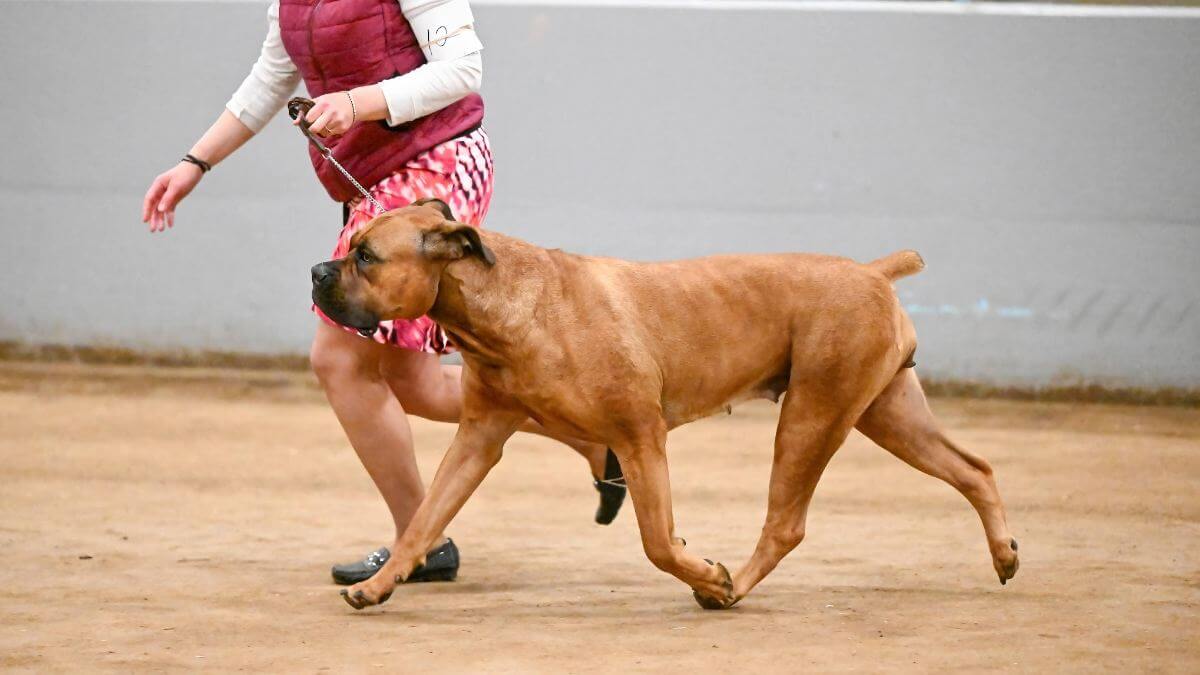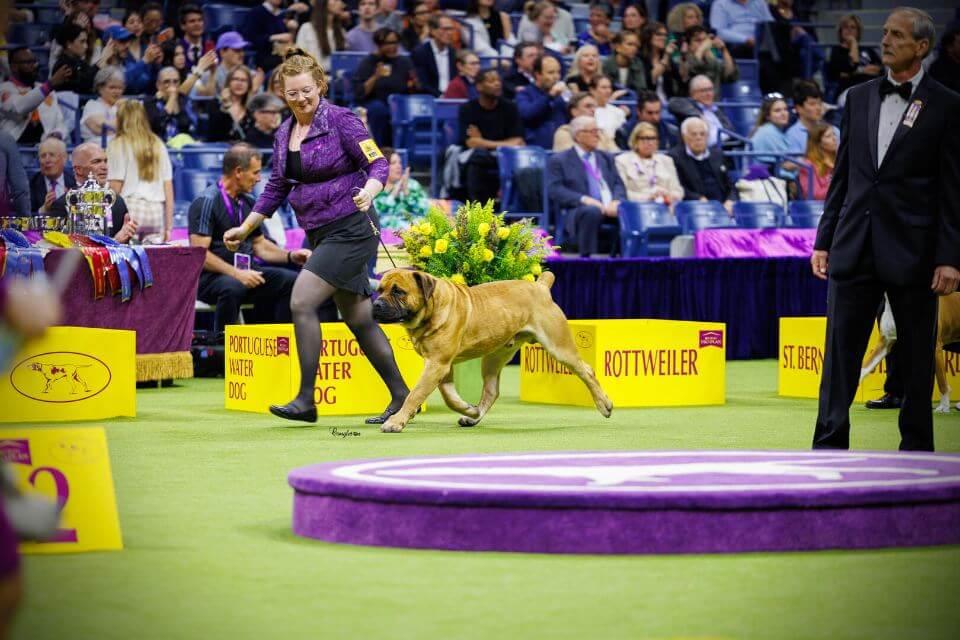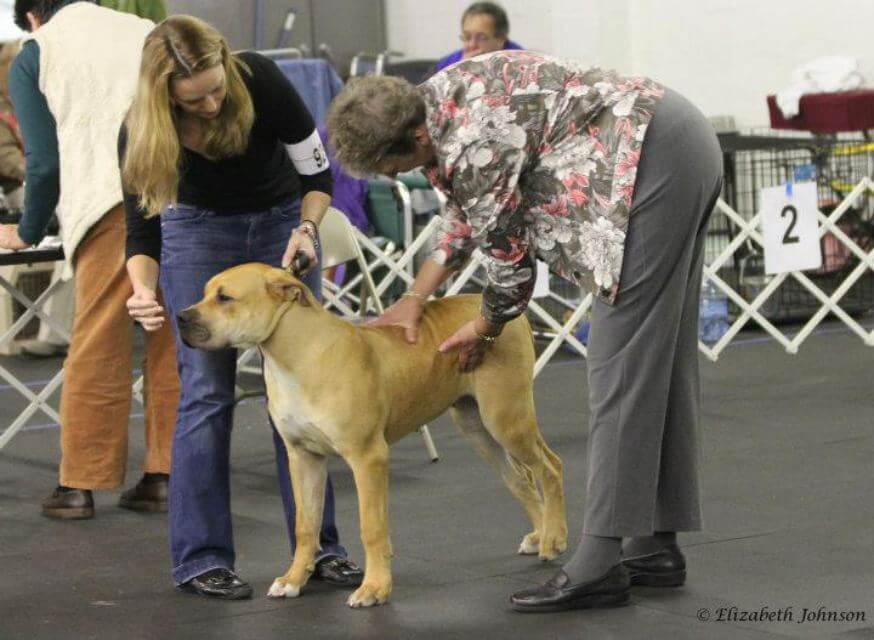


Home » Showing Your Boerboel – The Link Between Showing and Performance

If you are looking for a breed that can excel in a wide variety of AKC and other organizations’ sporting events and competitions, the versatile and agile Boerboel can be a brilliant choice, particularly for the experienced owner! Members of our breed parent club, the American Boerboel Club (ABC), have proudly described how enthusiastic and competitive their Boerboels are in a diverse array of sports, such as Barn Hunt, Weight Pulling, CAT and Fast CAT, Dock Diving, Agility, Nose Work, and many others! However, when I asked about Conformation showing, the general reaction was, “Why? It is SO boring!” I would submit that there is a very vital link between showing and performance—whether the subject is a competitor in sports, a family guardian, or a farm dog!

Many people think dog shows are simply rather boring events of recent origin in which dogs just walk or run in seemingly mindless circles around the ring. However, dog shows began about 150 years ago. The original purpose of dog shows was to evaluate breeding stock, and these shows are still quite important to the preservation and improvement of a breed (in our case, the Boerboel). In a dog show (also referred to as “Conformation showing”), each canine competitor is judged in terms of the extent to which he or she conforms to the breed’s Standard. The Breed Standard—owned, in this country, by the AKC designated parent club (for Boerboels, the ABC)—is the “template” or “blueprint” for what the ideal dog of that breed should look like, its expected attributes and abilities, and its temperament. A sound structure, conforming to the Breed Standard, should enable a Boerboel to excel not only in the show ring but as an able competitor in sporting events, or herding and protecting livestock on the farm!
While Breed Standards are not etched in stone, most breed clubs have been cautious about instituting changes. Most have attempted to remain true to the purpose, conformation, and valued characteristics of the breed. Our Standard provides a helpful “snapshot” of the Boerboel’s purpose by noting that, for the pioneer farmers who homesteaded in South Africa, “These dogs were often the first line of defense against predators… old farmers told many a tale of the strength, agility, and courage of the Boerboel.”

In the case of the modern Boerboel, this means a conformation and temperament that enables the outstanding athletic, agile, free-flowing, and supple movement and competitive drive that are hallmarks of the breed—contributing to its great success in sporting events and as a working dog. Additionally, if you are planning to become a breeder, achieving Conformation championships is an important step in establishing a successful kennel, one that will produce excellent representatives of our breed.
From my perspective, one of the more compelling reasons for getting in the show ring is that the Boerboel, which is a relative newcomer as an AKC recognized breed in the US (it was recognized in 2015), is confronting some serious challenges. One is an unfortunate, but seemingly growing, preference among some breeders and buyers for larger, Mastiff-sized Boerboels. Often this excessive size is accompanied by drooping jowls and excessive skin around the head and neck, which, as the Boerboel is a “head” breed, are entirely undesirable characteristics. Additionally, while a Mastiff-sized Boerboel may look very impressive, it will lose the desired agility, nimbleness, athleticism, and balance of our breed. Conversely, there are currently alleged “Boerboels” being produced that are undersized, “weedy,” “Ridgeback type” dogs, promoted as correct types. In my view, both are equally damaging to our breed!
Another challenge is the burgeoning popularity of off-standard coat colors in several breeds. Here is an excerpt from our Standard describing the Boerboel’s approved colors: “The coat is short, dense, smooth and shiny. The skin is thick and loose but fits smoothly. Skin is well pigmented. The recognized colors / patterns are with or without a mask; however, the black mask is desirable. Red, Brown, Reddish Brown, Fawn, Cream, brindle in any accepted color and Irish Marked. Limited clear white patches on the legs and the fore chest are permissible. Piebald, a white dog, with colored markings, total area of white may not exceed 33 percent or is disqualified, ticking or spots within the white to be disqualified. The Boerboel is well pigmented, especially on the lips, palate, the skin and hair around the eyes, nose leather, paw pads, toenails, the anus and the skin and hair around the genitals. Disqualifications—Blue colored (Powder Coat) dogs, any base color not listed, long coat, and nose leather in any color other than black.”
Unfortunately, even a cursory Internet search will reveal a significant number of sites advertising black dogs as “Boerboels.” A black coat in a “Boerboel” can only be a product of crossing with breeds carrying the K locus gene, such as Labs or Cane Corsos. It cannot be produced through breeding Brindle Boerboels, as black brindling is a pattern over an approved base coat.
These are the compelling reasons why it is more important than ever for owners, and particularly breeders, of Boerboels to show their dogs. It is in the show ring that our Boerboel can gain badly needed public visibility showcasing our breed!
One final word on getting started on Conformation showing. It is best to get started with a puppy, as the breed is not the easiest to show and they have very strong protective instincts. The Breed Standard states, “An aggressive or belligerent attitude toward other dogs should not be faulted.”
Initially, Conformation showing can be stressful; and there IS a lot to learn. However, it actually can be fun! Additionally, you may find that a Boerboel who is a champion in the show ring will most probably be an impressive contender and partner in any sports competition that draws your interest.